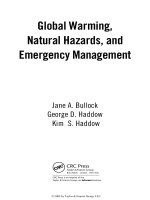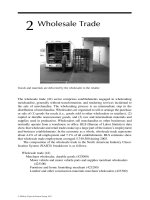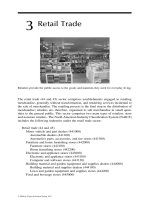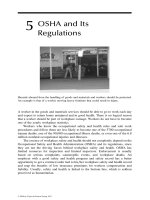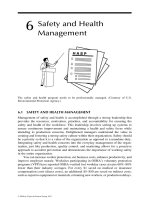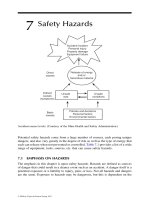Industrial Safety and Health for Goods and Materials Services - Chapter 1 docx
Bạn đang xem bản rút gọn của tài liệu. Xem và tải ngay bản đầy đủ của tài liệu tại đây (449.02 KB, 34 trang )
Industrial Safety
and Health for
Goods and Materials Services
ß 2008 by Taylor & Francis Group, LLC.
Handbook of Safety and Health for the Service Industry
Industrial Safety and Health for Goods and Materials Services
Industrial Safety and Health for Infrastructure Services
Industrial Safety and Health for Administrative Services
Industrial Safety and Health for People-Oriented Services
ß 2008 by Taylor & Francis Group, LLC.
HANDBOOK OF
SAFETY AND HEALTH FOR THE SERVICE INDUSTRY
Industrial Safety
and Health for
Goods and Materials Services
Charles D. Reese
ß 2008 by Taylor & Francis Group, LLC.
CRC Press
Taylor & Francis Group
6000 Broken Sound Parkway NW, Suite 300
Boca Raton, FL 33487-2742
© 2009 by Taylor & Francis Group, LLC
CRC Press is an imprint of Taylor & Francis Group, an Informa business
No claim to original U.S. Government works
Printed in the United States of America on acid-free paper
10 9 8 7 6 5 4 3 2 1
International Standard Book Number-13: 978-1-4200-5378-4 (Hardcover)
This book contains information obtained from authentic and highly regarded sources. Reasonable efforts
have been made to publish reliable data and information, but the author and publisher cannot assume
responsibility for the validity of all materials or the consequences of their use. The authors and publishers
have attempted to trace the copyright holders of all material reproduced in this publication and apologize
to copyright holders if permission to publish in this form has not been obtained. If any copyright material
has not been acknowledged please write and let us know so we may rectify in any future reprint.
Except as permitted under U.S. Copyright Law, no part of this book may be reprinted, reproduced, trans-
mitted, or utilized in any form by any electronic, mechanical, or other means, now known or hereafter
invented, including photocopying, microfilming, and recording, or in any information storage or retrieval
system, without written permission from the publishers.
For permission to photocopy or use material electronically from this work, please access www.copyright.
com ( or contact the Copyright Clearance Center, Inc. (CCC), 222 Rosewood
Drive, Danvers, MA 01923, 978-750-8400. CCC is a not-for-profit organization that provides licenses and
registration for a variety of users. For organizations that have been granted a photocopy license by the
CCC, a separate system of payment has been arranged.
Trademark Notice: Product or corporate names may be trademarks or registered trademarks, and are
used only for identification and explanation without intent to infringe.
Library of Congress Cataloging-in-Publication Data
Reese, Charles D.
Industrial safety and health for goods and materials services / Charles D. Reese.
p. cm.
Includes bibliographical references and index.
ISBN 978-1-4200-5378-4 (alk. paper)
1. Service industries United States Safety measures. 2. Service
industries Employees Health and hygiene United States. 3. Retail
trade Employees Health and hygiene United States. 4. Wholesale
trade Employees Health and hygiene United States. 5. Materials handling United
States Safety measures. I. Title.
HD7269.S452U6742 2009
658.3’82 dc22 2008013268
Visit the Taylor & Francis Web site at
and the CRC Press Web site at
ß 2008 by Taylor & Francis Group, LLC.
Contents
Preface
Author
Chapter 1 Intr oduction to the Servic e Industry
1.1 NAIC S
1.2 Emplo yment in the Servic e Industry
1.3 Sa fety
1.4 Why Trauma Prevent ion?
1.5 Acci dents or Incidents
1.6 Compre hensi ve Accident Prevention
1.7 Fa tality and Injury Pro file for the Servic e Indust ry
1.8 Occu pational Illnesses in the Se rvice Industry
Reference s
Chapter 2 Whole sale Tr ade
2.1 Pro fi le of Retail Worker s ’ Deaths, Injuries, and Ill nesses
2.1.1 Deaths
2.1.2 Injur ies
2.1.3 Illnesses
2.2 Haza rds Fa ced by Whole sale Worker s
2.3 Occu pations
2.4 Appl icable OSHA Reg ulations
Reference s
Chapter 3 Retail Trade
3.1 Retail Tr ade
3.1.1 Moto r Vehi cle and Part Deal ers
3.1.2 Clothi ng, Acce ssory , and Gene ral Merch andis e Stores
3.1.3 Groc ery Stores
3.2 Pro fi le of Retail Worker s ’ Deaths, Injuries, and Ill nesses
3.2.1 Deaths
3.2.2 Injur ies
3.2.3 Illnesses
3.3 Haza rds Fa ced by Retail Wo rkers
3.4 Occu pations
3.4.1 Moto r Vehi cle and Part Deal ers
3.4.2 Clothi ng, Acce ssory , and Gene ral Merch andis e Stores
ß 2008 by Taylor & Francis Group, LLC.
3.4 .3 Gro cery Stores
3.5 Appl icable OSHA Reg ulations
Reference s
Chapte r 4 Wareho using
4.1 Pro fi le of Wareho using Worker s ’ Deat h, Injur ies, and Illnesses
4.1 .1 Deaths
4.1 .2 Injur ies
4.1 .3 Illnesses
4.2 Haza rds Fa ced by Wareho using Workers
4.3 Occu pations
4.4 Appl icable OSHA Reg ulations
References
Chapte r 5 OSH A and Its Regulat ions
5.1 Fe deral Laws
5.2 OSH A
CT
5.3 Con tent of the OSHA
CT
5.4 Reg ulation Process
5.5 Fe deral Register
5.6 Pu rpose of OSHA
5.7 Cod e of Federal Regulat ions
5.8 CFR Numberi ng System
5.9 OSH A Standar ds Cov er
5.10 Cop ies of the OSHA Standar ds
5.11 Relief (Varianc e) from an OSH A Standard
5.12 OSH A
CT Protects
5.13 Nat ional Institu te for Occupati onal Safety and Heal th ’s Role
5.14 Occu pation al Safety a nd Heal th Review Com mission ’ s Role
5.15 Emplo yers Are Responsi ble for Worker s’ Safety and Heal th
5.16 Worker s ’ Ri ghts
5.17 Worker s ’ Res ponsibil ities u nder the Law
5.18 Right to Not Be Di scrimin ated Against
5.19 Right to Know
5.20 Env ironment al Moni toring Result s
5.21 Pe rsonal Protec tive Clothing
5.22 OSH A Inspec tions
5.23 OSH A Receives a Com plaint
5.24 Citat ions
5.25 Typ es of Violat ions
5.26 Cha llenging Citations , Penalties, and Ot her Enfo rcement Measures
5.27 Worker s Get the Res ults of an Inspec tion
5.28 Det ermining Pe nalties
5.29 State Programs
ß 2008 by Taylor & Francis Group, LLC.
5.30 Worker s ’ Tr aining
5.31 Occu pational Injuries and Ill nesses
5.32 Medi cal and Exp osure Rec ords
5.33 Po sting
5.34 Su mmary
Chapter 6 Sa fety and Health Manage ment
6.1 Sa fety and Health Manage ment
6.1.1 Safety and Heal th Polic y
6.1.2 Goals and Objectiv es
6.1.3 Visibl e Top Manag ement Leadershi p
6.1.4 Assignm ent of Responsi bility
6.1.5 Provis ion of Authori ty
6.1.6 Acco untabili ty
6.1.7 Program Evaluation
6.2 Sa fety and Health Prog rams
6.3 Rea sons for a Com prehensive Safety Pr ogram
6.4 Buildi ng a Sa fety and Health Pro gram
6.4.1 Manage ment Comm itment and Employee Invol vemen t
6.4.2 Haza rd Ident i fication and Assessm ent
6.4.3 Haza rd Preven tion and Con trol
6.4.4 Infor mation and Tr aining
6.4.5 Eva luation of Program Ef fectivenes s
6.4.6 Multiem ployer Workpl aces
6.5 Cha racteristics of an Occu pational Safety and Health Program
6.5.1 Factor s Affecting Safety and Heal th
6.6 Su mmary
Chapter 7 Sa fety Haza rds
7.1 Emphas is on Haza rds
7.2 Acci dent Cau ses
7.2.1 Direct Causes
7.2.2 Indir ect Causes
7.2.3 Basic Causes
7.3 Su mmary
Chapter 8 Heal th Haza rds
8.1 Occu pational Illnesses
8.2 Ident ifying Health Hazards
8.3 Heal th Haza rds
8.3.1 Acute Health Effects
8.3.2 Chronic Health Effects
8.3.3 Chronic Disease
8.3.4 Birth Def ects=Infer tility
ß 2008 by Taylor & Francis Group, LLC.
8.4 Biolog ical Moni toring
8.4 .1 Medi cal Ques tionnaire
8.4 .2 Pulm onary Function Tests
8.4 .3 Electr ocardio gram
8.4 .4 Che st X-Ray
8.5 Haza rdous Chemicals
8.5 .1 Carcino gens
8.6 Ioniz ing Rad iation
8.7 Noi se-Induced Hear ing Loss
8.8 Noni onizing Radiat ion
8.9 Temp erature Extremes
8.9 .1 Cold Stres s
8.9 .2 Heat Stres s
8.10 Vi bration
Reference
Chapte r 9 Che mical Hazards
9.1 Che micals
9.2 Rou tes of Entry and Modes of Act ion
9.2 .1 Eye s
9.2 .2 Lun gs and Inhal ation
9. 2.2.1 Respir ation
9.2 .3 Skin Absorpt ion
9.2 .4 Ingest ion
9.2 .5 Persona l Exposure Guides
9.3 Che mical Exposure Guidelines
9.3 .1 Time- Weigh ted Aver age
9.3 .2 Short- Term Exposure Li mits
9.3 .3 Ceili ng Limi t
9.3 .4 Skin Absorpt ion Not ation
9.4 Typ es of Airborn e Contam inants
9.4 .1 Dus ts
9.4 .2 Fumes
9.4 .3 Gas es
9.4 .4 Mis ts
9.4 .5 Vapo rs
9.5 Typ ical Haza rdous Che micals
9.5 .1 Solvent s
9.5 .2 Cleaners
9.5 .3 Acids and Bases
9.5 .4 Adhe sives and Sealant s
9.5 .5 Paint s
9.5 .6 Fuels
9.6 Exp osure Moni toring
9.7 Biolog ical Moni toring
ß 2008 by Taylor & Francis Group, LLC.
9.8 Can cer-Caus ing Che micals
9.9 Haza rd Communicat ions (1910.12 00)
9.9.1 Written HAZC OM Program
9.9.2 Infor mation Provid ed by the Employer
9.9.3 Traini ng Provided by the Em ployer
9.9.4 Multipl e Employe r Sites
9.9.5 Con clusions
9.10 Su mmary
Chapter 10 Comp ressed Gases
10.1 Cor rosive and Toxic Gas es
10.1. 1 Poison ous Gases
10.2 Prevent ing Compre ssed Gas Cylind er Accident s
10.2. 1 Cylind er Use
10.2. 2 Hand ling
10.2. 3 Storag e
1 0.2.3.1 Outsid e Storag e
1 0.2.3.2 Inside Storag e
10.2. 4 Movi ng Cylinders
10.2. 5 Transpor tation of Cylind ers
10.2. 6 Empty Cylind ers
10.2. 7 Ident ifi cation and Color Cod ing
10.2. 8 Adeq uately Securi ng Cylind ers
10.2. 9 Cylind er Storage Shed s
10.2. 10 Compat ibilit y
10.3 Hos es and Reg ulators
10.3. 1 Inspec tion .
10.3. 2 Gene ral Precaut ions
10.3. 3 Oper ation
10.3. 4 Safe Hand ling and Usage Guideli nes
10.4 Compre ssed Air Safety Guid elines
10.5 Cr yogenic Safety
10.5. 1 Gene ral Precaut ions
10.5. 2 Storag e
10.5. 3 Haza rds
10.5. 4 Haza rds to Personn el
1 0.5.4.1 Frostbite=Bur ns and Skin Lesions
1 0.5.4.2 Asphyxia tion
1 0.5.4.3 Obscured Vision
10.5. 5 Haza rds to Equipm ent
10.5. 6 Haza rds of Cryogens
1 0.5.6.1 Extreme Cold
1 0.5.6.2 Asphyxia tion
1 0.5.6.3 Toxic Hazards
1 0.5.6.4 Obscured Vision
ß 2008 by Taylor & Francis Group, LLC.
10.5.6.5 High Pressu re
10.5.6.6 Dewars in High Magnet ic Field s
10.5.6.7 Liquid Oxyg en
10.6 Prev enting Cryogeni c Accident s
10 .6.1 Dos
10 .6.2 Don ’ ts
10.7 Com pressed Gases in the Servic e Indust ry
10.8 OSH A Compre ssed Gas Regulat ions: Summary
10 .8.1 Compre ssed Gas Cylind ers
(29 CFR 1910.101 and .253)
10 .8.2 Acet ylene (29 CFR 191 0.253)
10 .8.3 Hydr ogen (29 CFR 1910.103 )
10 .8.4 Nitrou s Oxide (29 CFR 1910.105 )
10 .8.5 Oxyg en (29 CFR 1910.253 )
10 .8.6 Compre ssed Air (29 CFR 1910.242
and 29 CFR 1926.302 )
10.9 Com pressed Gas and Cylind er Che cklist
10.10 Su mmary
10 .10.1 Bas ic Safety
10 .10.2 Things Not to Do
Chapte r 11 Con trols and PPE
11.1 Haza rd Prevent ion and Control s
11.2 Eng ineering Control s
11.3 Awa reness Devices
11.4 Work Practi ces
11.5 Adm inistrative Controls
11 .5.1 Manage ment Con trols
11.6 Pe rsonal Protec tive Equipm ent
11 .6.1 Haza rd Assessment
11 .6.2 Establ ishing a PPE Program
11.7 Ran king Haza rd Controls
11.8 PPE Polic ies
11 .8.1 Safety Clothing
11 .8.2 Spe cial Protec tive Clothing
11 .8.3 Safety and Hair Pr otection
11 .8.4 Protec ting the Head
11 .8.5 Protec ting the Eyes and Face
11 .8.6 Ear Protec tion
11 .8.7 Protec ting Your Hand s
11 .8.8 Protec ting the Feet and Leg s
11 .8.9 Res piratory Pr otection
11.9 Su mmary
ß 2008 by Taylor & Francis Group, LLC.
Chapter 12 Emergen cies
12.1 Ident i fication of Hazards
12.2 Emergen cy Action Plans
12.2 .1 Eleme nts of an EAP
12.3 Al arm System
12.4 Eva cuation Plan and Policy
12.5 Emergen cy Resp onsibility
12.6 Exit Routes
12.6 .1 Req uirement s for Exits
12.6 .2 Safety Featur es for Exit Rou tes
12.6 .3 Des ign and Constr uction of Exits
12.7 Acco unting for Evacuees
12.8 Res cue Oper ations
12.9 Medi cal Car e in Emergen cies
12.10 Tr aining Emplo yees
12.11 Haza rdous Substances
12.12 Emergen cy Equ ipment
12.13 Su mmary
Chapter 13 Er gonomics
13.1 Ident ifying Haza rds
13.2 Er gonomical ly Risky Activi ties
13.2 .1 Work Activi ties
13.2 .2 Manual Material Hand ling
13.3 Er gonomic Risk Factors
13.3 .1 Des cription of Risk Factors
1 3.3.1.1 Force
1 3.3.1.2 Repeti tion
1 3.3.1.3 Awkward Postur es
1 3.3.1.4 Static Postures
1 3.3.1.5 Vibrat ion
1 3.3.1.6 Contact Stres s
1 3.3.1.7 Cold Tempera tures
13.4 Ph ysical Work Act ivities and Condit ions
13.5 Limi ts of Exposure
13.5 .1 Dur ation
13.5 .2 Frequency
13.5 .3 Magni tude
13.6 Er gonomic Control s
13.6 .1 Ident ify Con trols
13.6 .2 Assess Control s
13.6 .3 Impleme nt Controls
13.7 Tr acking Progress
13.8 Edu cation and Trainin g
13.9 Su mmary
ß 2008 by Taylor & Francis Group, LLC.
Chapte r 14 Fire Haza rds Guideli nes
14.1 Fire Haza rds
14.2 Cau ses of Fires
14.3 OSH A Standar ds Req uirement s
14.4 Avoi ding Fires
14.5 Fire Protec tion and Prevent ion
14 .5.1 Fire Protec tion
14 .5.2 Fire Prevent ion
14.6 Flam mabl e and Combus tible Liquid s (29 CFR 1910.106)
14 .6.1 Flam mable and Combus tible Liquids
14.7 Flam mabl e and Combus tible Mate rials
14.8 Fire Suppres sion Sy stems
14.9 Fire fighti ng
14.10 Fire Haza rd Che cklist
14.11 Su mmary
Chapte r 15 Hand Tools
15.1 Preve nting Hand Too l Accident s
15. 1.1 Hand Tool Key Points
15. 1.2 Stori ng Hand Tools
15. 1.3 Old Hand Tools
15. 1.4 Ergo nomics and Hand Tools
15. 1.5 Ergo nomically Des igned Hand Tools
15.2 Hand Tool Speci fic Safety
15. 2.1 Adju stable Wrench es
15. 2.2 Axes
15. 2.3 Box and Sock et Wrench es
15. 2.4 Carp enter ’ s or Claw Ham mer
15. 2.5 Chisel s
15. 2.6 Crowb ars
15. 2.7 Cutter s
15. 2.8 Files
15. 2.9 Hack saws
15. 2.10 Ham mers
15. 2.11 Hatc hets
15. 2.12 Kniv es
15. 2.13 Pipe Tongs
15. 2.14 Pipe Wrench es
15. 2.15 Plier s
15. 2.16 Punc hes
15. 2.17 Riveti ng Hamme rs
15. 2.18 Shov els
15. 2.19 Screw drive rs
15. 2.20 Spec ial Cutters
ß 2008 by Taylor & Francis Group, LLC.
15.2. 21 Tap and Die Work
15.2. 22 Tin Snips
15.2. 23 Wood Chisel s
15.2. 24 Wrench es
15.3 Use of Hand Too ls by the Se rvice Industry
15.4 Su mmary of OSHA Reg ulation for Hand Too ls (29 CFR 1910.242 )
15.5 Hand Tool Checklist
15.6 Su mmary
Chapter 16 Lad der Sa fety
16.1 Lad der Sa fety Program
16.1. 1 Manage ment ’s Comm itment
16.1. 2 Traini ng
16.1. 3 Haza rd Ident i fication
16.1. 4 Lad der Select ion
16.1. 5 Con trol and Prev ention
16.2 Dos
16.3 Don ’ ts
16.4 Use of Lad ders by the Servic e Industry
16.5 OSH A Ladder Standar ds
16.5. 1 Fixed Ladders (29 CFR 1910.27)
16.5. 2 Portab le Lad ders (29 CFR 1910.25 and .2 6)
16.6 Lad der Che cklist
Chapter 17 Lifti ng
17.1 Bac k Injur ies
17.2 Bac k Di sorders
17.2. 1 Factor s Associa ted with Back Disorde rs
17.2. 2 Before a Lift
17.3 Sy mptoms and Con tributors to Injur ies
17.4 Rec ords Rev iew: OSH A 300 Log
17.5 Eva luating Back Injuries
17.6 Manual Lifting
17.7 Prevent ion and Con trol
17.7. 1 Eng ineering Controls
17.8 Con trols and Wo rk Practi ces
17.9 Su mmary
Chapter 18 Machi ne Safety
18.1 Guar ding
18.2 Sa fe Practi ces Reg arding Machi ne Guards
18.3 Tr aining
18.4 Sa fe Oper ating Procedur es
ß 2008 by Taylor & Francis Group, LLC.
18. 4.1 Compone nts of an SOP
18. 4.2 Guide lines for Writing an SOP
18. 4.3 How SOPs Work
Reference
Chapte r 19 Mate rial Hand ling
19.1 Haza rds Invol ved
19.2 Sa fe Hand ling
19. 2.1 Manual Handlin g Sa fety
19. 2.2 Mechan ical Hand ling Equ ipment
19. 2.3 Safe Storag e of Mate rials
19. 2.4 Safe Stacki ng o f Mate rials
19. 2.5 Hous ekeepi ng
19.3 Mate rial-H andling Equipm ent
19. 3.1 Con veyors
19. 3.2 Crane s
19. 3.3 Sling s
19. 3.4 Forkli fts
19.4 Tr aining and Educati on
19.5 Mate rial Hand ling Regulat ions
19.6 Su mmary
Chapte r 20 Po wered Industria l Tr ucks (aka Forklifts )
20.1 Fo rklifts
20.2 Incid ence of Li ft-Truck Injuries
20. 2.1 Uns afe Act s and Condit ions
2 0.2.1.1 Unsafe Acts
2 0.2.1.2 Unsafe Condit ions
20.3 Haza rds an d Ef fects
20.4 Preve ntion Overview
20.5 Typ es of Power ed Indust rial Trucks
20.6 Protec tive Devi ces
20.7 Work Practi ces
20. 7.1 Select ion and Inspec tion of Trucks
20. 7.2 Main tenanc e and Rep air of Trucks
20. 7.3 Cha nging and Chargin g Storag e Batter ies
20. 7.4 Rated Cap acity
20. 7.5 Loa d Tes ting
20. 7.6 Indust rial Truck Namepl ate
20.8 Sa fety Tips for Oper ating Powered Indust rial Trucks
20. 8.1 Safe Opera tions
20. 8.2 Picki ng Up and Moving Loa ds
20. 8.3 Trave ling with a Loa d
20. 8.4 Stacki ng and Uns tacking Loa ds
ß 2008 by Taylor & Francis Group, LLC.
20.8 .5 Standar d Signals
20.8 .6 Safety Guards
20.8 .7 Truck s and Railr oad Car s
20.8 .8 Cowor ker Safety
20.8 .9 Pedest rian Sa fety
20.8 .10 Con duct of the Oper ator
20.9 Tr aining of Oper ators
20.9 .1 Gene ral Traini ng Require ments
20.9 .2 Traini ng Program Con tent
20.9 .3 Refreshe r Traini ng and Eva luation
20.9 .4 Ree valuation
20.9 .5 Avoi dance of Duplica tive Traini ng
20.9 .6 Certi ficatio n
20.9 .7 In-Ho use Traini ng Developm ent
20.9 .8 Drivin g Skill Evaluat ions
20.10 Appl icable Standar ds and Reg ulations
20.1 0.1 Forkli ft Trucks (Pow ered Indust rial Trucks)
(29 CFR 1910.178 )
20.11 Fo rklift Che cklist
20.12 Su mmary
Reference
Chapter 21 Workpl ace Securi ty and Violenc e
21.1 Workpl ace Securi ty and Violenc e
21.1 .1 Bac kground
21.1 .2 High -Risk Establ ishment s
21.2 Sy stematic Appro ach to Prevent ion
21.3 Manage ment Commitm ent and Emplo yee Invol vemen t
21.3 .1 Manage ment Com mitment
21.3 .2 Emplo yee Invol vement
21.4 Works ite Anal ysis .
21.4 .1 Comm on Risk Factors in Good s and Mate rials Sector
21.4 .2 Workpl ace Hazard Analysi s
21.4 .3 Rev iew of Rec ords and Past Incid ents
21.4 .4 Workpl ace Securi ty Analysi s
21.4 .5 Period ic Sa fety Audits
21.5 Haza rd Prevention and Control
21.5 .1 Prevent ion Strategies
21.5 .2 Eng ineering Controls and Workpl ace Adap tation
21.5 .3 Adm inistrative a nd Work Practic e Con trols
21.6 Po st-Incide nt Response
21.7 Tr aining and Educatio n
21.7 .1 Gene ral Traini ng
21.7 .2 Traini ng for Supervi sors, Manage rs,
and Securi ty Pe rsonnel
ß 2008 by Taylor & Francis Group, LLC.
21.8 Preve ntion Program Eva luations
21.9 Su mmary
Reference
Chapte r 22 Slips and Tr ips
22.1 Preve nting Slips and Trips
22.2 Preve nting Falls to the Same Lev el
22.3 Stair ways
22. 3.1 Inspec ting Stair ways
22.4 Preve nting Slips, Trips, an d Fa lls in the Se rvice Industry
22.5 Su mmary of OSH A Regulat ions
22. 5.1 Walki ng=Worki ng Surfaces (29 CFR 1910.21 and .22)
22. 5.2 Aisles and Pa ssageways (29 CFR 1910.17, .22, and .176)
22. 5.3 Floors (General Con ditions) (29 CFR 1910.22 and . 23)
22. 5.4 Guar ding Floor and Wall Openings (29 CFR 1910.23)
22. 5.5 Protec tion of Floor Open ings
22. 5.6 Raili ngs (29 CFR 1910.23)
22. 5.7 Stair s, Fixed Industria l (29 CFR 1910.23 and .24)
22. 5.8 Toe boards (29 CFR 1910.23)
22.6 Che cklist for Walking=Worki ng Su rfaces
22.7 Su mmary
Chapte r 23 Ot her Haza rds
23.1 Comp ressors and Com pressed Air (29 CFR 1910.242 )
23.2 Con trol of Haza rdous Energy Sources (L ockout=Tagout)
(29 CFR 1910.147 )
23.3 Dock boards (29 CFR 1910.30)
23.4 Electr ical (29 CFR 1 910.303, . 304, .305, .331, and .333)
23.5 Fu eling
23.6 Po rtable (Power-O perated) Tools and Equ ipment
(29 CFR 1910.243 )
23.7 Sc affolds (29 CFR 1910.28)
23.8 Tire In flatio n
23.9 Workpl ace Violenc e
Chapte r 24 Su mmary
24.1 Che micals
24.2 Comp ressed Gas Cylind ers
24.3 Cr ane Sa fety
24.4 Emergen cy Resp onse and Planni ng
24.5 Er gonomics
24. 5.1 Manual Material Hand ling
24. 5.2 Physic al Ene rgy Demands
ß 2008 by Taylor & Francis Group, LLC.
24.5 .3 Other Muscu loske letal Dem ands
24.5 .4 Env ironment
24.5 .5 Gene ral Workpl ace
24.5 .6 Too ls
24.6 Fire Protec tion and Prevent ion
24.7 Fo rklifts
24.8 Hand and Portable Power Too ls
24.8 .1 Hand Tools and Equ ipment
24.9 Haza rd Commun ication
24.10 Heal th Haza rds
24.11 Lad ders
24.1 1.1 Portab le W ooden Lad ders
24.1 1.2 Portab le Meta l Ladders
24.1 1.3 Fixed Ladders
24.12 Lifti ng Sa fety
24.13 Machi ne Guarding and Safety
24.14 Mate rial Hand ling
24.1 4.1 Mate rial Handlin g Equipme nt
24.1 4.2 Storag e Areas
24.1 4.3 Hous ekeepi ng
24.15 Means of Exit
24.16 Medi cal Se rvices and First Aid
24.17 Riggin g
24.18 Slips , Trips, and Falls
Appendi x A Comm on Exposure s or Acciden t Types
A.1 Accident Types
A.1.1 Struck -Ag ainst Types of Acci dents
A.1.2 Struck -By Typ es of Accident s
A.1.3 Con tact-B y and Con tact-With Types of Accident s
A.1.4 Cau ght-In and Caught- On Typ es of Accident s
A.1.5 Cau ght-Bet ween Types-O f Acci dents
A.1.6 Fa ll-to-Same-L evel and Fall-to-Bel ow Typ es of Accident s
A.1.7 Over exert ion and Exposure Types of Acci dents
Appendi x B Sampl e and Blank Mate rial Safety Data Sheets
Appendi x C Persona l Pr otective Equ ipment Hazard Assessm ent
Appendi x D Assault Incid ent Report Fo rm
Bibliograp hy
ß 2008 by Taylor & Francis Group, LLC.
ß 2008 by Taylor & Francis Group, LLC.
Preface
Industrial Safety and Health for Goods and Materials Services deals with goods and
materials services, which include the wholesale trade, retail trade, and warehousing
and storage sectors. These three sectors handle myriad goods and materials such as
furniture, construction materials, machines, equipment, paper products, appliances,
hardware items, drugs and sundries, apparel, groceries, chemicals, petroleum prod-
ucts, beverages, assorted parts, electronic devices and products, and farming prod-
ucts. These are all packed in both large and small boxes or containers that must be
handled, unpacked, sorted, and placed on displays or shelv es by the workforce.
The workers in these three sectors face similar occupationally related safety and
health hazards. Some of these hazards are compressed gases, ergonomics-related
issues, lifting, material handling, slips, trips, falls, fires, hand tools, chemicals,
machines, and equipment.
Although the aforementioned hazards are not the only hazards faced by workers
in these sectors, they are the most common ones. Because of the diversity in the
wholesale trade, retail trade, and warehousing and storage services, other job-specific
hazards may result.
This workforce is susceptible to several hazards because of the constant handling
and moving of a variety of goods and materials. These hazards can be managed by
applying the principles of identification, intervention, and prevention, all of which
are proven techniques of occupational safety and health.
In today’s work environment, workers must be trained for emergencies and
security must be provided for both workers and patrons. By adhering to acceptable
safe work practices and occupational safety and health regulations, the safety and
health of the workforce can be ensured while running a productive business. This
book serves as a guide in achieving this objective.
Charles D. Reese, PhD
ß 2008 by Taylor & Francis Group, LLC.
ß 2008 by Taylor & Francis Group, LLC.
Author
For 30 years, Charles D. Reese, PhD, has been involved with occupational safety
and health as an educator, manager, and consultant. In his early career, Dr. Reese
was an industrial hygienist at the Nationa l Mine Health and Safety Academy. He
later became manager for the nation’s occupational trauma research initiative at the
National Institute for Occupational Safety and Health’s Division of Safety Research.
Dr. Reese has played an integral role in trying to ensure workplace safety and health.
As the managing director for the Laborers’ Health and Safety Fund of North
America, he was responsible for the welfare of the 650,000 members of the laborers’
union in the United States and Canada.
Dr. Reese has developed many occupational safety and health training programs,
which range from radioactive waste remediation to confined space entry. He has also
written numerous articles, pamphlets, and books on related issues.
Dr. Reese, professor emeritus, was a member of the graduate and undergradu-
ate faculty at the University of Connecticut, where he taught courses on Occupa-
tional Safety and Health Administration regulations, safety and health management,
accident-prevention techniques, industrial hygiene, and ergonomics. As professor of
environmental=occupational safety and health, he was instrumental in coordinating
the safety and health efforts at the University of Connecticut. He is often invited to
consult with industry on safety and health issues and is asked for expert consultation
in legal cases.
Dr. Reese is also the principal author of the Handbook of OSHA Construction
Safety and Health (Second Edition); Material Hand ling Systems: Designing
for Safety and Health; Annotated Dictionary of Construction Safet y and Health;
Occupational Health and Safety Management: A Practical Approach;andOffice
Building Safety and Health and Accident=Incident Prevention Techniques.
ß 2008 by Taylor & Francis Group, LLC.
ß 2008 by Taylor & Francis Group, LLC.
1
Introduction to the
Service Industry
The service industry consists of many different places of work, called establish-
ments. Establishments are physical locations in which people work, such as a branch
office of a bank, a gasoline station, a school, a department store, or an electricity
generation facility. Establishments can range from large retail operations with
corporate office complexes employing thousands of workers to small comm unity
stores, restaurants, professional offices, and service businesses employing only a few
workers. Establishments should not be confused with companies or corporations that
are legal entities. Thus, a company or corporation may have a single establishment or
more than one establishment.
Establishments that use and provide the same services are organized together
into industries. Industries are in turn organized together into industry sectors. These are
further organized into subsectors. Each of the industry groups requires workers with
varying skills and employs unique service techniques. An example of this is found in
utilities, which employs workers in establishments that provide electricity, natural gas,
and water. The service industry is broken down into the following supersectors:
Trade
Retail trade (44 and 45)
Wholesale trade (42)
Retail stores sell many of the goods and materials provided by the goods and materials
services sector.
ß 2008 by Taylor & Francis Group, LLC.
Transportation and utilities
Transportation (48)
Warehousing (49)
Utilities (22)
Information services (51)
Financial activities
Financial and insurance sector (52)
Real estate and rental and leasing sector (53)
Professional and business services
Professional, scientific, and technical services (54)
Management of companies and enterprises (55)
Administrative and support and waste management and remediation (56)
Education and health services
Educational services sector (61)
Health care and social assistance sector (62)
Leisure and hospitality
Arts, entertainment, and recreation sector (71)
Accommodation and food sector (72)
Other services (81)
The service industry is the fastest growing industrial sector in the United States
and has seen growth in the international arena. The service industry accounts for
approximately 70% of the total economic activity in the United States according to
the U.S. Bureau of Census. This non-goods-producing industry, which includes
retail trade, wholesale trade, and other service-related industries as previously men-
tioned, has a very diverse grouping.
1.1 NAICS
With the passage of the North American Free Trade Agreement (NAFTA), it became
apparent that the long employed standard industrial classification (SIC) was no
longer very useful when dealing with industries found in Canada and Mexico.
Consequently, the Bureau of Labor Statistics has developed a new system entitled
the North American Industrial Classification System (NAICS).
NAICS uses a six-digit hierarchical coding system to classify all economic
activity into 20 industry sectors. Five sectors are mainly goods-producing sectors
and 15 are entirely services-producing sectors.
1.2 EMPLOYMENT IN THE SERVICE INDUSTRY
To have some idea of the numbers of employees addressed when speaking of the
service industry, the wor ker population in each of the service industry sector is
provided. The fast growing service industry as well as the number and variety of
ß 2008 by Taylor & Francis Group, LLC.
occupations withi n eac h secto r provides a window into the safety and health hazards
that n eed to be addres sed withi n each sector of the servi ce indus try ’s workforce
(Table 1.1).
1.3 SAFETY
One of the most telling indi cators of working condition is an indus try’ s inju ry and
illness rates . Overexert ion, being stru ck by an object, and fall s o n the same level are
among the most common incidents causing wor k-related injuries.
The servi ce industry is a large umbr ella that encom passes many types of
businesses , each of whi ch has its own safet y and health issues. Some of the
service industries ’ busin esses are more hazardo us than other s. This book does not
address each secto r indepe ndently, but provi des the tool s and infor mation needed to
address the hazards and safet y and healt h issues withi n each secto r of the service
industry.
The servi ce indus try is made up of a large numbe r of wi dely dissimilar indus try
sectors. Eac h secto r has its own unique funct ions that result in each sector having its
own set of unique hazards that the indi vidual wor kforce s must face and that their
employers must address.
TABLE 1.1
Employ ment in the Service Indu stry (2004 )
Service Industry Sectors Employment
Percentage of
Service Industry
(84,896,300)
Percentage of All
Private Industries
(107,551,800)
Wholesale trade 5,642,500 6.6 5.2
Retail trade 15,060,700 17.7 14.0
Warehousing 555,800 0.65 0.52
Transportation 3,450,400 4.1 3.2
Utilities 583,900 0.69 0.54
Administrative and support and
waste management and remediation
7,829,400 9.2 7.3
Information 3,099,600 3.7 2.9
Finance and insurance 5,813,300 6.8 5.4
Real estate 2,077,500 2.4 1.9
Management of companies and enterprises 1,696,500 2.0 1.6
Professional, scientifi c, and technical services 6,768,900 8.0 6.3
Education services 2,079,200 2.4 1.9
Health and social services 14,005,700 16.5 13.0
Art, entertainment, and recreation 1,852,900 2.2 1.7
Accommodation and food services 10,614,700 12.5 9.9
Other services 3,785,200 4.5 3.5
Source: From Bureau of Labor Statistics. United States Department of Labor. Available at http:==www.
bls.gov, Washington 2007.
ß 2008 by Taylor & Francis Group, LLC.


